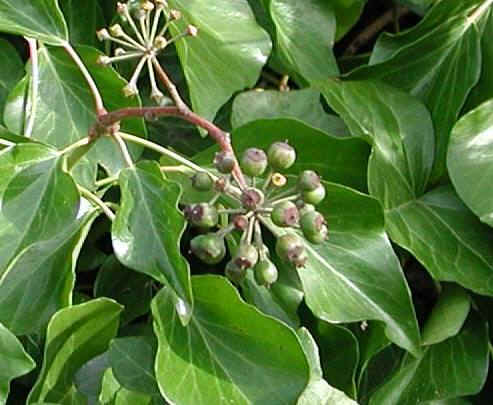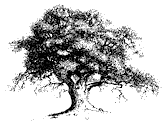|
Saanich
is a paradise for gardeners. Unfortunately enthusiastic gardeners
have unwittingly unleashed horticultural horrors on the landscape.
These are vigorous plants that crowd out all others when they are
transplanted locally and freed from the conditions that keep them
in check in their places of origin. This is the first article of
what will be an occasional series in these pages. |
Many people continue to plant
English ivy [Hedera helix and H. hibernica] in their gardens,
unaware that it is a non-native plant that invades our woodlands and
forests with devastating effect. It outcompetes natives, reduces numbers
and kinds of other plants and impairs the landís ability to support
wildlife. It is so destructive that many jurisdictions, including Washington
state, list it as a noxious weed. Saanich has been urged to list it
also, but has not yet acted. Locally, Swan Lake-Christmas Hill Nature
Reserve is infested with ivy along the trails.
When English ivy climbs into trees,
it may weaken the host tree by shading out deciduous foliage during its
growing period, preventing the normal contact of bark with air and microorganisms,
and acting as a sail when the wind is blowing, which contributes to blow-down.
It is shallowly rooted, so it is ineffective for erosion control, and
may actually contribute to erosion problems. Heavy infestations can provide
shelter for undesirable pests such as rats.
Ivy contains chemical compounds
that may irritate the skin. Eating the leaves can harm browsing animals.
English ivy can grow 9-10 months
of the year in our area, which is one factor that allows it to dominate
in wild areas where there are no gardeners to keep it under control. It
has an interesting life history. The attractive leaves for which it is
planted are juvenile forms. When it climbs, or sometimes when it has been
growing on the ground for a long time, it produces larger, unlobed mature
leaves. It then begins to flower and set berries. It blooms in the fall,
and matures nutritious fruits in early spring when other foods are scarce.
Birds eat the berries and excrete the seeds, all ready to grow in their
own little fertilizer packages.
|

Juvenile leaves have three to five lobes in the classic "ivy"
shape. Plants remain in juvenile form for at least ten years
|

Mature English ivy leaves with immature berries
|
Control
Control of English ivy is difficult.
Herbicides do not penetrate well because of the waxy surface of its leaves,
and it is tolerant of many of the most commonly used. Hand-pulling is
a more effective method, but requires commitmentóthe writer has been pulling
ivy annually from one area for 17 years! Even the tiniest piece of root
left behind in the soil will continue to send up shoots. Theoretically
repeated pulling will exhaust the plantís nutrient reserves and it will
then die, but as my experience shows, it is very robust!
Do not try to compost English ivy.
After it is pulled it must be removed to a place, such as a patio, where
it is not in contact with soil. It will dry out and die after about a
week if the mass is not so large it retains moisture. It can also be packed
in black plastic garbage bags that are placed in the sun and rotated so
that all plants are heated.
Last Words
If you donít have English ivy in
your garden, donít plant it. If you do have it, control it.
English ivyís role in gardens is
as a ground cover. Some native plants that can carpet the ground include
wild strawberries [Fragaria spp.], fringe cup [Tellima grandiflora],
longleaf Oregon grape [Mahonia nervosa] [thatís the low-growing
of the two species most commonly seen in this area], redwood sorrel [Oxalis
oregana], kinnikinnick [Arctostaphylos uva-ursi], bunchberry
[Cornus canadensis], vanilla leaf [Achlys triphylla] or
false lily-of-the-valley [Maianthemum]. Horticultural plants that
can do the job and are more easily kept under control [Please! No periwinkle!]
include deadnettle [an ugly name for a small creeper with variegated leaves
and pink or white flowers in season, also known as Lamium], some
hardy geraniums, London pride, lavender, rockcress, ornamental strawberry,
some forms of cotoneaster, lithodora, and so on. Consult such resources
as the Sunset Western Garden Book, or your favorite nursery for
other ideas.
For more information, Saanich has
a brochure about ivy that is available at the Municipal Hall.
... or check out the web; here are a few sites to get you going:
 |
Global
Invasive Species Database 
|
 |
NO
Ivy League (Oregon) 
|







